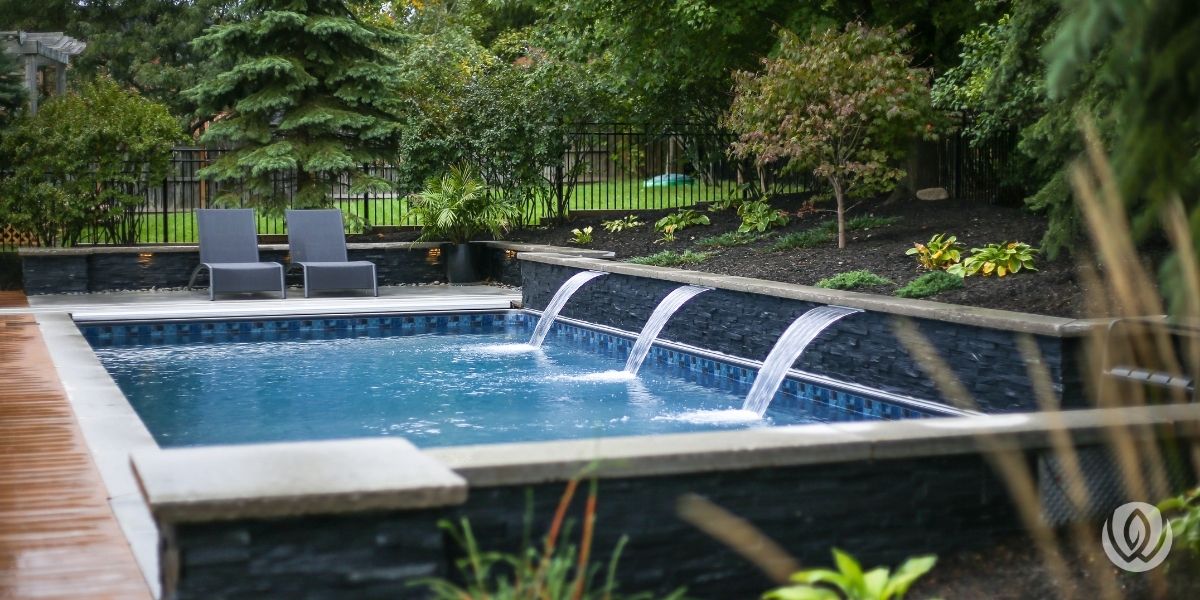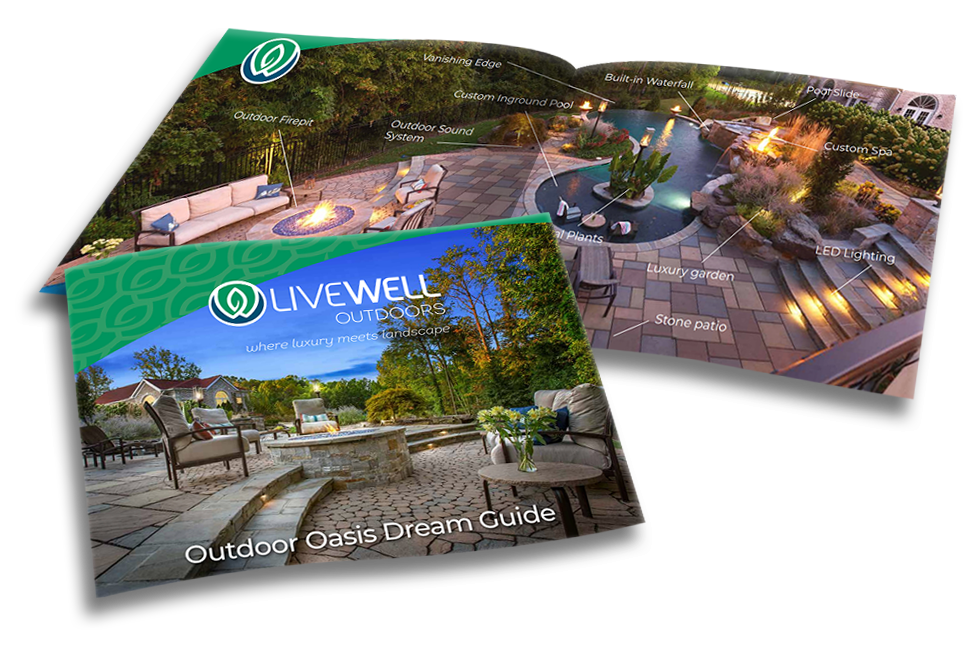
Imagine this: you’ve just moved into a home in an HOA community in Maryland. You’re planning to build a custom composite deck with a cedar pergola, add a built-in outdoor kitchen, refresh the in-ground pool, and install a natural stone retaining wall to rework the slope.
You’ve got a clear vision—something timeless, well-crafted, and built to last. But before construction begins, there’s one thing standing between your plans and the build site: HOA approval.
Between reviewing CC&Rs, preparing detailed design submissions, responding to architectural feedback, and coordinating county permits, the process can quickly become more involved than expected.
This guide walks through each step clearly and practically, with insights from LiveWell Outdoors to help you move from design to approval with confidence.
Before tackling applications and approvals, get clear on what you want to build—and how your homeowners association may influence it. Most HOA communities have rules that shape what you can do in your backyard, from materials to layout.
Common HOA rules may address:
Even something as simple as your paver finish or pergola design could require sign-off. Planning your vision around these details early makes the process smoother.
How LiveWell Helps: We guide your design process to align with common HOA rules without sacrificing style or function.
Every homeowners association is governed by a set of documents known as the CC&R—short for Covenants, Conditions & Restrictions. These documents outline what’s allowed, what’s restricted, and what requires formal approval in your community. That includes everything from structural changes and exterior finishes to landscaping, fencing, lighting, and outdoor living features.
Before you design anything, it’s important to read the current CC&R—and not just rely on what your neighbor told you was “probably fine.”
Here’s how to find it:
These rules may include highly specific design restrictions—like setback distances, structure height, or approved materials. For example, if your project includes an outdoor kitchen grill, your HOA may require it to be a certain distance from property lines or made with finishes that match your home’s exterior.

How LiveWell Helps: We’ll help you review the CC&R, spot design limitations early, and shape your plans to align with the rules—without sacrificing style, functionality, or your vision for the space.
Most HOA communities require a formal application before work can begin. Your package may include:
Every HOA has its own process. Some boards are flexible, while others require specific file types, sample materials, or meeting attendance.
If you’re planning something multi-layered—like the example from the intro with a deck, pergola, outdoor kitchen, and retaining wall—you’ll likely need to submit multiple views and technical details to show how the pieces work together.
How LiveWell Helps: We prepare everything your HOA board needs, reducing delays caused by missing documents or vague design language.
Once submitted, your project enters the HOA review process. Some committees meet monthly, others quarterly. Reviews can take anywhere from a few days to several weeks.
It’s not uncommon for boards to request adjustments. You might need to slightly reposition a retaining wall, revise a pergola height, or swap out a material for something on the approved list. For a project that involves multiple elements—like a deck, kitchen, and pool refresh—it’s especially important to be flexible without compromising your vision.

How LiveWell Helps: We handle any back-and-forth with your HOA and make quick adjustments that keep your project moving forward.
HOA approval is just one part of the process. You may also need permits from your county or city, especially if your project involves:
HOAs care about aesthetics and design standards. Local governments care about safety and building code compliance. You need both.
How LiveWell Helps: We handle the full permitting process alongside your HOA submission, so nothing falls through the cracks.
Once your HOA and permit approvals are secured, construction can begin. Starting early—even for site prep or deliveries—can trigger violations or neighbor complaints.
Waiting for the green light avoids issues down the line.
How LiveWell Helps: We schedule every phase of construction based on confirmed approvals, so your project stays compliant and on track.
Some homeowners' associations require final documentation or inspections after your project is complete. Others may request photos or a statement confirming compliance with the approved design.
Don’t skip this step. Unfinished paperwork can create issues later, especially when selling your home.
How LiveWell Helps: We help wrap up the final details, ensuring your project is closed out cleanly with your HOA.
Even a well-prepared application can hit a snag. Boards may deny projects for reasons ranging from setback violations to aesthetic concerns—even if those concerns feel subjective.
Here’s what to do:
For example, if your plan includes custom lighting along a stone pathway and the HOA limits uplighting or visible fixtures, you may need to switch to shielded, low-voltage options. Or if your retaining wall overlaps a setback line, a small shift in layout could be enough to gain approval.

How LiveWell Helps: We handle revisions and resubmissions, so the process stays professional and streamlined—even when things don’t go as planned.
Not every HOA rule is valid or legally binding. Some associations enforce policies that fall outside their authority or haven’t been properly adopted.
Unenforceable HOA rules may include:
For example, your HOA may try to restrict something like solar panels or drought-tolerant landscaping—both of which may be protected under local laws. Or, a denial based on “aesthetic preferences” not outlined in any official documents could be open to challenge.
If a rule feels vague, unfair, or selectively enforced, ask for clarification. Compare it with the written policies. You might have more room to push back than you think.
How LiveWell Helps: While we don’t provide legal advice, we’ve seen enough HOA processes to recognize when a rule deserves a second look. We’ll raise those concerns early and help guide you through a practical path forward.

A homeowners association manages shared neighborhood standards and common areas. They enforce rules on exterior changes like decks, fences, pools, landscaping, and more.
Almost always. Most HOAs require approval for anything that alters your yard’s appearance or structure—including fences, outdoor kitchens, retaining walls, lighting, or even plant selections.
Yes. HOAs can adopt new rules or update existing ones through board votes or formal amendments. Homeowners are expected to stay informed—even if a rule wasn’t in place when you moved in.
It varies by community. Some HOAs review applications within a week, while others meet monthly or quarterly. If revisions are needed, the timeline can stretch longer.
Yes. HOA approval covers aesthetics and neighborhood guidelines. Local permits ensure your project meets safety and zoning codes. Most outdoor projects require both.
You may face fines, be forced to stop construction, or even have completed work removed. It’s always safer—and often faster—to follow the approval process upfront.
Rules that conflict with local or state laws, aren’t outlined in the CC&R, or are applied inconsistently may be unenforceable. If something seems off, ask to see the written policy.
It could be a legacy installation, a violation that went unnoticed, or their project might’ve been approved under different guidelines. Each submission is reviewed individually—even if it feels unfair.

If you're building in an HOA community, understanding the rules is the first step. With a clear process and the right team behind you, it doesn’t have to be overwhelming.
Whether your dream project includes a deck, retaining wall, built-in kitchen, or a pool upgrade—or all of the above—LiveWell Outdoors has helped hundreds of homeowners across Maryland, D.C., and Northern Virginia bring those ideas to life.
We handle the red tape—so you can focus on the results.
Schedule a consultation today and bring your vision to life with LiveWell Outdoors.
